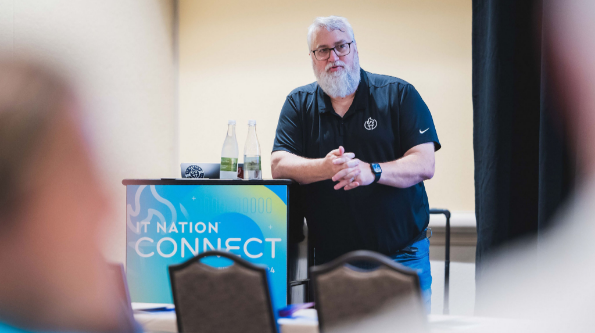Ryan Goodman is one of the Founders of ConnectBooster and serves as its President.
No one enjoys asking for money.
This is especially true with customers. But avoiding the topic can lead to trouble down the road. Take the example of aging accounts receivables (A/R); it's not always an immediate threat to a business, but MSPs will find that ever-expanding A/R is a sure growth killer.
It can be challenging to maintain healthy cash flow if revenue doesn’t come into the business consistently. Furthermore, it causes problems when applying for various business loans to increase your portfolio or fund a new business venture.
The trouble is, these issues never resolve themselves. Customers tend to forget or ignore paying their bills unless they are top of mind, or they'll wait till it's convenient for them. That’s a substantial problem that doesn’t go away unless you address it and implement processes to minimize that growing A/R and prevent it from spiraling out of control.
MSPs can invest a lot of time and money on manual collections and still not end up getting paid, leaving a business with no way to recover those investments. Even if late paying customers eventually send a check for overdue invoices, unless there is a significant late-payment fee, those collections costs will remain on the expense side of your company’s accounting ledger.
Building a strategy is key for success
Reducing your MSP’s aging accounts receivables is not impossible, but it does require some planning to see results. You could start by deciding as a business to transition to a recurring revenue payment plan and require autopay from all customers.
The problem is, MSPs must have several discussions with prospective customers, from infrastructure improvements and new solution options, to the cost-effective monthly charge for providing excellent services. Through all the technology and service expectations, laying out how a customer is supposed to pay for their services can easily be missed in the sales and onboarding process.
Failing to establish payment expectations in the sales stage is only one of the issues driving your A/R balances higher. Thankfully, there’s hope for MSPs who want to get paid on time without having to always prod and stalk their customers. Your odds of success will improve significantly by following these three steps.
1. Establish clear expectations up front
Before ever signing a contract, a new customer should be aware of what is required of them when it’s billing time. Mention it in the sales process, as they are reviewing the contract of service, get them to acknowledge and understand what’s expected from them.
At this point in the sales process, expectations around things such as the onboarding process, implementation, and support, should already be established. Price negotiations are already complete, so laying out how they pay for your services should be a standard part of this process.
Set up your process to become the new normal for customers. Billing related to recurring services should be automatically set up on autopay, with project work and other one-time purchases potentially being the exceptions. That should be a standard discussion with prospects and newly signed customers. You will need to carry on a much different conversation with your existing customers.
2. Adopt tools that automate your payment process
MSPs already rely on tools like PSAs and RMMs to automate their ticketing and billing processes, and monitor their environments. But they should always be looking for additional ways for these tools to automate menial tasks. So, why not implement similar “hands off” solutions for your payments, as well?
Customers who rarely stay on top of paying their bills create more legwork for MSPs trying to build a strong payment process.
Businesses with well-defined systems and policies on payment expectations tend to be paid on time because their customers don’t know anything different. Loose agreements can confuse or allow clients to “fill in the blanks” with their preferred payment plan. Systems that provide customer alerts enable users to review invoice details and let them make changes to their payment methods help motivate prospects to “buy in” to the program.
The thing is, most of your customers have the means and ability to pay on time each month. An automated payment system with full transparency simplifies the process and keeps cash flowing into your business on a recurring monthly basis.
3. Try and get over 80% of your customers on autopay
While getting 100% of customers on autopay should always be the end goal, there will be special exceptions or customers who refuse to budge. For most MSPs wanting to reduce their aging accounts receivables, a practical objective is to get over 80% of customers to be on recurring billing. This strategy allows you to manage the remaining percentage of customers not on autopay and prevent serious cash flow issues.
Reaching 80% of your customers on autopay has amazing consequences and is one of the best ways to curb your aging accounts receivables. It also means your business will have a steady invoice of cash without tons of time spent collecting it, and you’ll be able to plan for future growth and secure loans with ease.
Converting your existing customer base to recurring billing can be tricky, but it’s possible to get the majority to sign up just by presenting it as a convenient option or offering a small discount for autopay. Persuading the few who refuse to switch to autopay can be a different story, but with a lower number of customers in that group, you can look at the business and make the decision about how to proceed on a case-by-case basis.
Deciding when to end a long-term customer partnership isn't easy and may not present a straightforward answer. But this should not be true for any new customers. Establish a clear rule that every new customer must agree to autopay, or you will not begin service. This should keep your aging accounts receivables low and prevent future problems to your cash flow.
Create a timeline to adopt these strategies
MSPs can significantly improve their finances by implementing an autopay structure, but doing so requires a clear business plan. From developing a roadmap for onboarding new customers with a strict payment schedule, to slowly creating messaging to incentivize current customers to adopt automated billing. All these steps are crucial to achieving that goal of 80% or more of your customers on automatic billing.
Remember, adopting autopay methods will drastically impact your aging accounts receivables, but rolling out autopay requires trust--handing over permission for a vendor to bill them whenever is intimidating and has the potential for abuse. Every customer has reservations about handing over such power to anyone.
In order remain open and transparent, ensure you use a payment tool that allows for detailed invoices to be sent explaining the charges and give them the ability to update their payment information and see their billing history.













